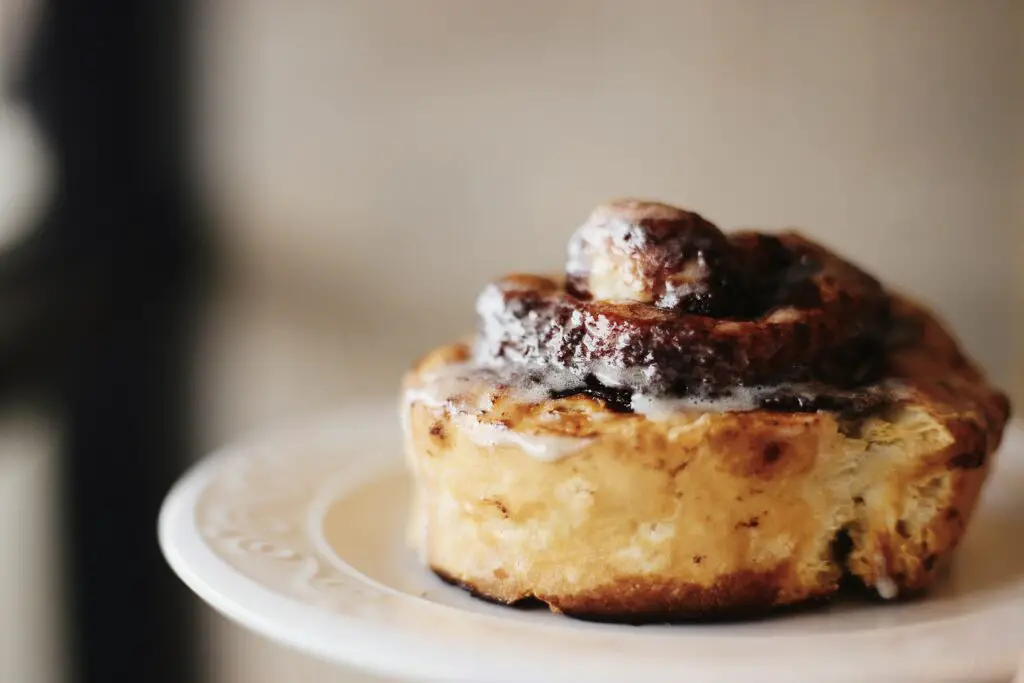There’s nothing like the smell of fresh cinnamon rolls filling the kitchen. It’s warm, cozy, and feels like a hug from the oven.
Picture this: It’s Sunday morning. You’ve got a hot cup of coffee, soft music playing, and these gooey, buttery rolls rising on the counter.
This isn’t just any cinnamon roll recipe. It’s the one. Fluffy centers, golden edges, and a cream cheese frosting that melts just right.
Ready to bake the best cinnamon rolls of your life? Let’s get started.
What Makes These Cinnamon Rolls the Best?
A Secret Step That Changes Everything
Let’s talk about the game-changer: a warm, heavy cream soak just before baking. Yep, you pour a bit of heavy cream over the rolls before they go into the oven.
It seeps into the dough, steams the bottom, and transforms each bite into soft, gooey perfection.
Think bakery-style rolls, but better—because you made them. This step keeps them ultra-moist and gives them that irresistible, melt-in-your-mouth center.
And if you’re wondering—yes, it makes a huge difference.
Cinnamon-Sugar Filling That’s Just Right
Some cinnamon rolls are too sugary. Others taste like dry bread dusted with cinnamon. Not these.
The filling is perfectly balanced—softened butter, rich brown sugar, and the right amount of ground cinnamon. No grittiness. No dry patches. Just a gooey swirl of sweet spice in every bite.
Want to level it up? Add a pinch of salt to the mix. It cuts through the sweetness and brings out the warm flavor even more.
Dough So Soft, It Barely Needs Chewing
Here’s the truth: dry cinnamon rolls are a crime against carbs.
This dough is made with warm milk, eggs, and butter, which gives it richness. But the real key? A slow, proper rise and a gentle hand. Don’t rush it.
Letting the dough rise until it’s truly doubled gives it that signature pillowy texture. And using bread flour (instead of all-purpose) adds a slight chew that’s still tender.
The result? Rolls that are soft enough to tear with your fingers, but structured enough to hold the filling like a champ.
That Cream Cheese Frosting, Though
The frosting isn’t just an afterthought. It’s the crown. Smooth, rich, and just sweet enough, it’s made with real butter, softened cream cheese, vanilla, and powdered sugar.
No shortcuts. No weird aftertaste. Just a thick, velvety layer that slowly melts into the warm rolls like icing on a cloud.
Want a pro tip? Frost the rolls while they’re still warm—but not hot. That way, the frosting melts slightly, fills the cracks, but still holds its shape on top.
Ingredients You’ll Need
Here’s everything you need to make the softest, most decadent cinnamon rolls from scratch. Measure carefully—precision makes all the difference!
For the Dough:
- 1 cup warm whole milk (about 110°F / 43°C)
- 2¼ tsp active dry yeast (or one standard packet)
- ¼ cup granulated sugar
- 2 large eggs, room temperature
- ⅓ cup unsalted butter, melted and slightly cooled
- 4 cups bread flour (start with 3¾ cups, add more as needed)
- 1 tsp salt
For the Filling:
- ½ cup unsalted butter, very soft (almost melted)
- 1 cup packed brown sugar (light or dark)
- 2½ tbsp ground cinnamon
For the Frosting:
- 4 oz cream cheese, softened
- ¼ cup unsalted butter, softened
- 1 tsp vanilla extract
- 1½ cups powdered sugar, sifted for smoothness
Optional Add-Ons:
- ½ cup chopped pecans or ½ cup raisins (mix into the filling or sprinkle on top)
- 1 tsp orange zest (add to the frosting for a citrusy twist)
Step-by-Step Instructions
Step 1: Make the Dough
Start by warming 1 cup of whole milk until it’s about 110°F (warm but not hot to the touch). Pour the milk into a large mixing bowl and sprinkle 2¼ tsp active dry yeast over it.
Let it sit for 5–10 minutes until it gets foamy. That’s how you know your yeast is awake and ready.
Next, whisk in ¼ cup granulated sugar, 2 eggs, and ⅓ cup melted unsalted butter. Mix until everything looks smooth and combined.
Now add 3¾ cups of bread flour and 1 tsp salt. Stir until a shaggy dough forms.
Then, either knead by hand for about 8 minutes or use a stand mixer with the dough hook on medium speed for 5–6 minutes.
Add extra flour, 1 tablespoon at a time, if the dough is too sticky. You’re aiming for a smooth, soft, and slightly tacky ball of dough.
Step 2: First Rise
Place the dough in a lightly greased bowl. Cover it with a clean towel or plastic wrap.
Let it rest in a warm, draft-free spot for about 1 hour, or until it doubles in size. If your kitchen is cold, try placing the bowl inside a turned-off oven with the light on. Works like a charm.
Step 3: Prepare the Filling
While the dough is rising, get the filling ready.
In a small bowl, mix 1 cup brown sugar with 2½ tablespoons ground cinnamon. Stir well so there are no clumps.
In a separate bowl, make sure ½ cup unsalted butter is very soft. Not melted, but spreadable like room-temp cream cheese. This makes it easier to slather evenly on the dough later.
Step 4: Roll, Fill, and Cut
Once your dough has doubled, punch it down gently. Turn it out onto a lightly floured surface and roll it into a large rectangle—about 16×12 inches.
Spread the softened butter all over the surface, right to the edges. Then evenly sprinkle your cinnamon-sugar mixture across the entire rectangle. Don’t leave bald spots!
Starting on the long side, roll the dough tightly into a log. Try to keep it snug but not squished.
Use unflavored dental floss or a sharp knife to cut the log into 12 even rolls. If using floss, slide it under the log, cross it on top, and pull—clean slices every time.
Step 5: Second Rise
Place the rolls in a greased 9×13-inch baking dish, leaving a little space between them.
Cover again and let them rise for another 30–45 minutes, until they’re puffed and touching.
Optional but magical: Right before baking, pour ½ cup warm heavy cream over the rolls. It soaks in and makes them extra gooey.
Step 6: Bake
Preheat your oven to 350°F (175°C).
Bake the rolls for 20–25 minutes, until the tops are lightly golden and the centers are cooked through. If the tops brown too fast, loosely cover the dish with foil halfway through.
Don’t overbake—you want soft, pillowy rolls, not dry ones.
Step 7: Make the Frosting
While the rolls bake, whip up the frosting.
In a bowl, beat 4 oz cream cheese, ¼ cup softened butter, and 1 tsp vanilla extract until smooth.
Add 1½ cups powdered sugar, a little at a time, and keep beating until you get a fluffy, spreadable consistency.
If it’s too thick, add a splash of milk. Too thin? Add a little more sugar.
Step 8: Frost While Warm
As soon as the rolls come out of the oven, give them a minute or two to cool slightly—then frost generously.
Spread the frosting over the warm rolls so it melts into every crevice, swirl, and edge. Don’t be shy—this is the good stuff.
And there you have it—cinnamon rolls that look and taste like they came straight from a bakery window. Soft, gooey, and absolutely unforgettable!
Expert Tips for Perfect Rolls
Even the best recipe can fall flat without the right technique.
These small, smart tweaks will make your cinnamon rolls go from good to unbelievable.
Trust the process, but also trust these tips—they’re battle-tested in home kitchens.
Use Room-Temperature Ingredients
Cold ingredients = sluggish dough.
When your milk, eggs, and butter are too cold, they can slow down the yeast and throw off the rise. This leads to dense, heavy rolls. Not what we want.
Let everything sit out for 30–45 minutes before starting. If you’re in a hurry, gently warm your milk and submerge eggs in warm water for a few minutes.
Room-temp ingredients help the dough come together faster and rise more evenly, giving you that cloud-like texture.
Roll the Dough Evenly
This one sounds basic, but it’s a big deal. Uneven dough leads to uneven baking.
When rolling out your dough, try to keep it about ¼-inch thick across the entire surface. If one side is thinner, those rolls will overbake while the thicker ones stay doughy.
Use a rolling pin with guides or just eyeball it carefully. Think of it like wrapping a present—you want crisp, even folds for the best end result.
Cut Using Dental Floss
Yes, dental floss. No, not mint flavored.
It’s one of the oldest baking hacks in the book, and it works like a charm. Floss slices through soft dough without squishing it—something knives often fail to do.
Just slide the floss under the rolled log, cross it over the top, and pull tight. You’ll get perfect rounds every time, no tearing, no mess.
Bonus: It’s oddly satisfying.
Don’t Overbake
This might be the most important tip of all.
Cinnamon rolls keep cooking a little even after they come out of the oven. If you bake them until they look totally done, they’ll end up dry.
Instead, pull them out when the tops are golden but the centers still look soft. A slightly underbaked center gives you that dreamy, gooey swirl that everyone fights over.
If you’re not sure, insert a knife into the center roll—if it comes out with just a little resistance and no raw dough, you’re golden.
Storage & Make-Ahead Instructions
Cinnamon rolls are best fresh, but let’s be honest—life gets busy, and leftovers happen.
To store them, place fully cooled rolls in an airtight container or wrap them tightly with foil or plastic wrap.
They’ll stay soft for up to 3 days at room temperature, or you can refrigerate them to extend freshness a bit longer—just warm before serving so the frosting gets melty again.
Want to prep ahead? No problem. For freezing before baking, follow all the steps up to slicing the rolls and placing them in the pan.
Instead of letting them rise the second time, cover the pan tightly and freeze it.
When you’re ready to bake, thaw the rolls in the fridge overnight, then let them come to room temperature and rise until puffy before baking as usual.
It’s a great way to have fresh-baked cinnamon rolls on a lazy weekend morning without starting from scratch.
If you’ve already baked them and want to freeze leftovers, allow the rolls to cool completely (frosting and all), then wrap each one individually in plastic wrap and foil, or place them in a freezer-safe bag.
When you’re ready to enjoy, reheat in the microwave for about 30 seconds or in a low oven until warm and gooey.
They won’t taste exactly like day-one rolls—but honestly? They’ll still knock your socks off.
Variations to Try
Love the classic cinnamon roll, but feeling adventurous? These fun twists keep things interesting and let you tailor the recipe to the season, your mood, or your dietary needs—without sacrificing flavor or coziness.
Maple Glaze Instead of Cream Cheese Frosting
If you’re not a fan of cream cheese (yes, those people exist), or just want something a bit more subtle, try a maple glaze.
Mix 1 cup powdered sugar with 2–3 tablespoons of pure maple syrup and a splash of milk or cream until smooth and pourable. Drizzle it over warm rolls and let it drip into every swirl.
It’s sweet, warm, and gives off major cozy cabin vibes. Add a pinch of cinnamon or nutmeg if you’re feeling fancy.
Pumpkin Cinnamon Rolls
For a seasonal spin, turn your dough into pumpkin heaven. Swap out ½ cup of milk for ½ cup canned pumpkin purée, and mix 1½ teaspoons pumpkin spice into your filling.
The pumpkin keeps the dough extra soft and adds that earthy sweetness we all crave in the fall.
Pair it with maple glaze or keep the classic frosting—it works either way. These are basically autumn in edible form.
Apple Cinnamon Filling for a Fall Twist
Want to take your cinnamon rolls from sweet to next-level dessert? Add a chopped apple sautéed in butter, cinnamon, and brown sugar to the filling.
Use a firm variety like Granny Smith or Honeycrisp so it holds up during baking.
The apples add juicy bites and extra warmth, turning your rolls into something between a cinnamon bun and an apple pie. Perfect for holidays—or honestly, any random Tuesday.
Vegan Version with Plant-Based Swaps
Yes, you can make these dairy- and egg-free without losing that melt-in-your-mouth magic.
Use plant-based milk (like almond or oat), vegan butter, and egg replacers like flaxseed meal or unsweetened applesauce (¼ cup per egg).
For the frosting, grab a vegan cream cheese or go simple with a glaze of powdered sugar and non-dairy milk.
The rolls still come out soft, rich, and totally crave-worthy. Even non-vegans will be asking for seconds.
Common Mistakes to Avoid
Even seasoned bakers slip up from time to time. But a few tiny missteps can turn your dreamy cinnamon rolls into sad, dry spirals.
Here’s what to watch out for and how to steer clear of baking heartbreak.
Using Cold Milk
This one’s a deal-breaker. Yeast needs warmth to wake up and do its job. If your milk is straight from the fridge, your yeast won’t activate properly, and your dough might not rise at all.
You’ll end up with dense, sad little pucks instead of fluffy rolls. Warm the milk until it’s about 110°F (43°C)—that’s warm to the touch, but not hot.
Too hot, and you’ll kill the yeast. Too cold, and it never gets going. Yeast is picky like that.
Adding Too Much Flour
We get it—sticky dough is annoying. But don’t overcompensate by dumping in extra flour. Too much and your rolls will turn out dry, tough, and heavy.
Always start with the lower amount of flour the recipe calls for, then add more a tablespoon at a time only if needed. The dough should be soft, slightly tacky, but not a sticky mess.
If it’s clinging to your hands like gum, go ahead and add a touch more. But err on the side of under rather than over.
Not Letting the Dough Rise Enough
Impatience is the enemy of good cinnamon rolls. Skipping or rushing the rise time is like pulling a cake out of the oven halfway through—it just won’t work.
The dough needs to double in size during both rises. This gives it structure, softness, and that airy texture you’re after.
If your kitchen is cold, give the dough extra time or use a warm spot like the inside of an (off) oven with the light on.
If it hasn’t risen enough, don’t bake it yet—wait it out. Your future self will thank you.
Frosting Too Early or Too Late
Timing is everything with frosting. Do it too soon, and it’ll melt right off into a puddle. Wait too long, and it won’t spread or soak in properly.
The sweet spot? About 5–10 minutes after the rolls come out of the oven. They should still be warm to the touch, but not steaming.
That way, the frosting melts just enough to seep into the swirls while still staying thick and luscious on top. It’s like a warm blanket over a fresh-out-the-oven hug.
Final Words
These cinnamon rolls are everything you want in a homemade treat—soft, gooey, and topped with rich, melty frosting. No shortcuts, just real ingredients and bakery-style results.
Give them a shot this weekend. Your kitchen will smell amazing, and your taste buds will thank you.
Tried this recipe? Tag us in your cinnamon roll pics—we’d love to see!
FAQ’s
Can I make these overnight?
Yes, cover shaped rolls and refrigerate before the second rise. Let them come to room temperature before baking.
Can I use instant yeast instead of active dry?
Yes—just skip the proofing step and mix directly into the dry ingredients.
What if I don’t have a stand mixer?
Hand-kneading works fine—just knead for 8–10 minutes.
Can I double the recipe?
Yes—perfect for parties or gifting.



